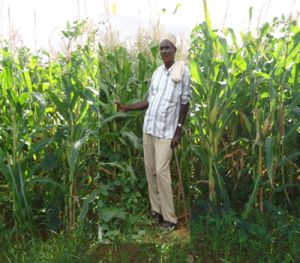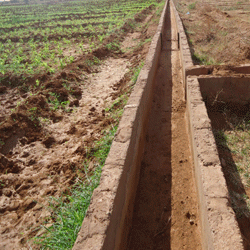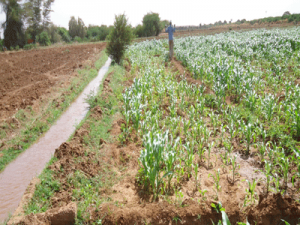BP1 Project
BP1 irrigation scheme is located at BP1 location at Mandera East sub county of drought prone Mandera County, the scheme is bound by Somalia to the East and Ethiopia to the North.
BP1 irrigation scheme is 10 km from the Mandera town. The scheme falls under the irrigation command area of a seasonal river called the River Daua. The command area of the River Daua is about 120Ha (hectares) and serves 305 farmers. The average land holding is about 0.5 Ha or less. The river is the main source for supporting livelihood activities in the county at large.

Transformation
The community has made great strides in food security, reduction in extreme poverty and enrollment has increased in local academic institutions (primary to secondary). Two projects were started by FFA in the area i.e: Construction of 200m lined concrete canal & 4km earth canal construction..200m concrete canal recently constructed which opened up 20Ha-new under irrigation.
Non food items issued to the beneficiaries
The community has made great strides in food security, reduction in extreme poverty and enrollment has increased in local academic institutions (primary to secondary). Two projects were started by FFA in the area i.e: Construction of 200m lined concrete canal & 4km earth canal construction..200m concrete canal recently constructed which opened up 20Ha-new under irrigation.

Most tail-end farmers complained of not getting water in their farms as the canals could not deliver water quickly due to soil wetting and losses; fuel consumption efficiency has improved from 1Lt/Acre- 1Lt/4 Acres (80% reduction on fuel costs). Jabril Hussein one of the project beneficiaries remembers the initial status and the difficulties of growing only one crop. “Before the irrigation canal, I only grew maize and a small amount of other crops like cowpeas,” Jabril Hussein explains. “All of the crops I grew were used for my family – I did not have enough to sell. I did not even have enough to feed my family all the time. It’s impossible to develop your life with just maize and cowpeas. You must diversify to ensure against any pests, wild animals or low market prices,” he said. “I can now grow many different crops as well as grass for the animals and sale the surplus to raise money for school fees. These are all benefits of a productive farm.”
Yield before and after the intervention

Current picture
In 2014, the BP1 Irrigation Scheme is touted as an exemplary case of well managed irrigation scheme. The Project has triggered activities in other irrigation schemes in the county. However farmers in the scheme are faced with a challenge of acquiring farm inputs (consumable and consumable farm inputs) to expand the scheme and more has not been done as regards to training of local Water user Association (WUA) on good Irrigation Management to optimize profits from their farms. Based on my conversations with farmers, the success of the BP1 project can be attributed to two types of measures: first, robust support from CP,NDMA and WFP in terms of Non food items, enlightened project committee to assist in implementation monitoring and sustainability of the assets done and second, continuous replication water efficiency irrigation technologies. Since 2012 April, FFA beneficiaries have been continuously repairing and rehabilitating a 4km primary irrigation earth canal and laterals, jumpstarting production and allowing farmers like Jibril to produce enough food to eat and sell the surplus produce. With only 9 months of irrigation period, Jabril is able to grow far more produce. which has allowed him to realize his vision for a diverse, self-contained and productive farm – and made him one of the most successful farmers in BP1.
Food resources issued to beneficiaries

Further conversation with Jabril revealed that most farmers in the scheme prefer to use maize as fodder as compared to dry corn because fodder fetches high returns in the larger Mandera town market. The main reasons are; first, most people in the region are not regular users of corn but instead they sell maize fodder and buy their favorite food eg. Rice and pasta. Second, little time and money are spent in transporting the goods to the market and lastly there is high demand for fodder in the neighboring country of Somalia. Farmers have found the project more worth compared to the initial amount invested for constructing the assets
The results are tabulated as follows.

Farmers said that their average income from agriculture has increased is in the range of almost 2 times than what it was 3 years ago. In an area where they could not dream of growing “high risk value crops “ and vegetables, farmers now regularly grow crops throughout the irrigation period (9months) which require high levels of reliable water supply. Cases of malnutrition in the village are rare as the community has wider varieties of food for consumption. These have contributed to reduction of extreme poverty and hunger.




